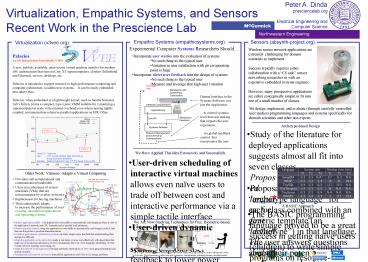Virtualization, Empathic Systems, and Sensors - PowerPoint PPT Presentation
Title:
Virtualization, Empathic Systems, and Sensors
Description:
Peter A. Dinda presciencelab.org Electrical Engineering and Computer Science. Virtualization, Empathic Systems, and Sensors Recent Work in the Prescience Lab – PowerPoint PPT presentation
Number of Views:58
Avg rating:3.0/5.0
Title: Virtualization, Empathic Systems, and Sensors
1
Peter A. Dindapresciencelab.orgElectrical
Engineering and Computer Science.
Virtualization, Empathic Systems, and
Sensors Recent Work in the Prescience Lab
Empathic Systems (empathicsystems.org)
Sensors (absynth-project.org)
Virtualization (v3vee.org)
- A new, publicly available, open source virtual
machine monitor for modern x86 architectures
that runs on Cray XT supercomputers, clusters
(Infiniband and Ethernet), servers, desktops,
etc. - Palacios is intended to support research in high
performance computing and computer architecture,
in addition to systems. It can be easily
embedded into other OSes. - Palacios, when embedded in a lightweight kernel,
such as Sandia National Labs Kitten, forms a
compact, type-I pure VMM suitable for
virtualizing a supercomputer at scale with
minimal overhead even when running tightly
coupled, communication-intensive parallel
applications on HPC OSes.
Experimental Computer Systems Researchers Should
Wireless sensor network applications are
extremely challenging for domain scientists to
implement. Success typically requires either
collaboration with a CS side sensor networking
researcher or with an expensive embedded systems
engineer. However, many prospective applications
are either conceptually simple or fit into one of
a small number of classes.
- Incorporate user studies into the evaluation of
systems - No such thing as the typical user
- Variation in user satisfaction with given
operating point is huge - Incorporate direct user feedback into the design
of systems - No such thing as the typical user
- Measure and leverage that high user variation
Human Interface to the Systems Software, not
just the Application to control systems-level
decision making that impacts the user
experience via global feedback control that
incorporates the user
We design, implement, and evaluate (through
carefully controlled user studies) programming
languages and systems specifically for domain
scientists and other non experts
Archetype-based Design
- Study of the literature for deployed applications
suggests almost all fit into seven classes. - Proposal develop an archetype language for
each class combined with an generic template (an
archetype) in that language. The user answers
questions about their potential application to
lead to an archetype. He modifies the archetype
for his specific purposes. The system
synthesisizes a hardware/software design. - Archetype languages are designed for domain
scientists. They are also extremely high-level,
allowing expression of the archetype in a page of
code, and freeing the hands of the synthesis and
compilation toolchains.
We Have Applied This Idea Extensively and
Successfully
- User-driven scheduling of interactive virtual
machines allows even naïve users to trade off
between cost and interactive performance via a
simple tactile interface - User-driven dynamic voltage and frequency scaling
exploits user feedback to lower power consumption
on a laptop computer by considerable amounts
while maintaining high user satisfaction. - UDFS (user presses button when irritated) 22
better than Windows DVFS - PICSEL (evaluates rate of screen content change)
12.1 better - iDVFS (neural net maps from hardware measures to
per-user satisfaction) 25 better - PTP (biometrics-based satisfaction) 12 better
- Speculative remote display predicts and draws
server screen content on the client, ameliorating
network latency effects. Naïve users can trade
off between display correctness and
responsiveness. - Empathic network link scheduling provides user
satisfaction-driven control over scheduling the
broadband router link in home networks. It
increases overall user satisfaction by 24 over
an FCFS link, and by 19 compared to a static WFQ
link. - User-presence-driven display power management
controls laptop LCD backlight based on presence
determined by ultrasonic sonar on commodity
hardware
Older Work Virtuoso Adaptive Virtual Computing
Proposed language for first identified archetype
has high success rate and low development time in
user study comparing it to other languages
- Providers sell computational and communication
bandwidth - Users run collections of virtual machines (VMs)
that are interconnected by overlay networks - Replacement for buying machines
- That continuously adaptsto increase the
performance of your existing, unmodified
applications and operating systems
A BASIC Approach
- The BASIC programming language proved to be a
great success in getting naïve users (children)
to write simple programs on resource-constrained
embedded systems (the millions of home computers
of the early 80s). - We have developed an BASIC for use in sensor
networks. The language is extended with sensor
network concepts needed for writing node-oriented
programs, and these concepts are presented via
user study-tested constructs found to be sensible
to non-programmers. - Depending on the task, 45-55 of subjects with no
prior programming experience can write simple,
power-efficient, node-oriented sensor network
programs after a 30 minute tutorial. 67-100
of those matched to typical domain scientist
expertise can do so.
We Are Now Studying Techniques for Free,
Biometric-based, Continuous Measurement of User
Satisfaction
- Monitor application traffic Use applications
own traffic to automatically and cheaply produce
a view of the applications network and CPU
demands and of parallel load imbalance - Monitor physical network using the applications
own traffic to automatically and cheaply probe
it, and then use the probes to produce
characterizations - Formalize performance optimization problems in
clean, simple ways that facilitate understanding
their asymptotic difficulty - Adapt the application to the network to make it
run faster or more cost-effectively with
algorithms that make use of monitoring
information to drive mechanisms like VM-gthost
mapping, scheduling of VMs, overlay network
topology and routing, etc. - Adapt the network to the application through
automatic reservations of CPU (incl. gang
scheduling) and optical net paths - Transparently add network services to unmodified
applications and OSes to fix design problems
Left to right keystroke force sensors, galvanic
skin response, pupil dilation, active ultrasonic
sonar Not shown blood pressure, pulse rate and
dynamics, temperature, infrared camera,
accelerometer































